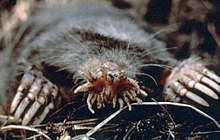Condylura is a genus of moles that contains a single extant species, the star-nosed mole (Condylura cristata) endemic to the northern parts of North America.[1] It is also the only living member of the tribe Condylurini.
| Condylura | |
|---|---|

| |
| Star-nosed mole (Condylura cristata) | |
| Scientific classification | |
| Domain: | Eukaryota |
| Kingdom: | Animalia |
| Phylum: | Chordata |
| Class: | Mammalia |
| Order: | Eulipotyphla |
| Family: | Talpidae |
| Subfamily: | Scalopinae |
| Tribe: | Condylurini Gill, 1875 |
| Genus: | Condylura Illiger, 1811 |
| Type species | |
| Sorex cristatus Linnaeus, 1758
| |
| Species | |
| |
While today endemic to New World, fossil evidence suggests the genus was once much more widespread, with two named species (C. kowalskii and C izabellae) known from the Pliocene of Poland and an unnamed species from the Mid Miocene of Kazakhstan.[2]
Condylura is classified along with other New World moles in the subfamily Scalopinae by most authorities; however, more recent studies suggest that it occupies a much more basal position in Talpidae, being sister to a clade comprising the fossil genus Geotrypus, all living Talpinae, and all Scalopini. The extinct genus Eotalpa could potentially be a sister genus to it.[3]
References
edit- ^ Feldhamer, George A.; Thompson, Bruce C.; Chapman, Joseph A., eds. (2003). Wild Mammals of North America: Biology, Management and Conservation (2nd ed.). Baltimore, Maryland: Johns Hopkins University Press. ISBN 9780801874161.
- ^ Sansalone, G.; Kotsakis, T.; Piras, P. (2016). "Condylura (Mammalia, Talpidae) reloaded: New insights about the fossil representatives of the genus". Palaeontologia Electronica. 19 (3). doi:10.26879/647. hdl:11380/1318332.
- ^ Schwermann, Achim H.; He, Kai; Peters, Benjamin J.; Plogschties, Thorsten; Sansalone, Gabriele (2019). "Systematics and macroevolution of extant and fossil scalopine moles (Mammalia, Talpidae)". Palaeontology. 62 (4): 661–676. doi:10.1111/pala.12422. ISSN 1475-4983. S2CID 134096608.